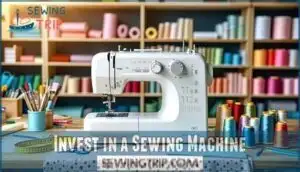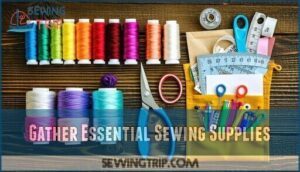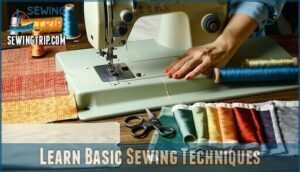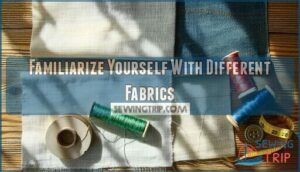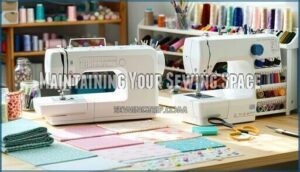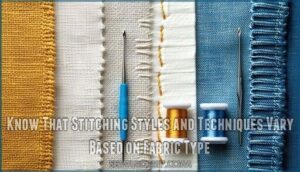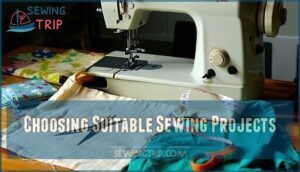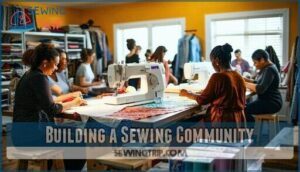This site is supported by our readers. We may earn a commission, at no cost to you, if you purchase through links.
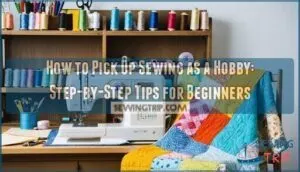 Learning how to pick up sewing as a hobby starts with gathering essential tools: a reliable sewing machine, quality thread, and sharp fabric scissors. You’ll want to set up a dedicated workspace with good lighting and comfortable seating to keep supplies organized.
Learning how to pick up sewing as a hobby starts with gathering essential tools: a reliable sewing machine, quality thread, and sharp fabric scissors. You’ll want to set up a dedicated workspace with good lighting and comfortable seating to keep supplies organized.
Start with simple projects like pillow covers or tote bags to build confidence before tackling complex items. Understanding different fabric types—from cotton’s forgiving nature to silk’s luxurious challenge—helps you choose materials that match your skill level.
Regular practice with both hand stitching and machine techniques transforms this therapeutic craft into a rewarding creative outlet. The real magic happens when you discover the endless possibilities waiting in your fabric stash.
Table Of Contents
Key Takeaways
- Start with basic tools and a dedicated workspace – You’ll need a reliable sewing machine, quality thread, sharp fabric scissors, and good lighting to set yourself up for success.
- Begin with simple projects to build confidence – Practice on forgiving fabrics like cotton with easy projects like pillow covers or tote bags before tackling complex items.
- Focus on learning fundamental techniques first – Master basic stitches, threading, and fabric handling before moving on to advanced patterns and tricky materials.
- Join a sewing community for support and inspiration – Connect with local guilds or online groups to share projects, get troubleshooting help, and stay motivated in your sewing journey.
Getting Started With Sewing
You’re about to start your sewing journey, so gather some simple tools and a bit of patience—you’ll need both, especially if your first needle decides to play hide and seek.
With a bit of practice and a few laughs along the way, you’ll be stitching projects before you know it.
Invest in a Sewing Machine
When you’re starting out in sewing as a hobby, picking your first sewing machine is like choosing a trusty sidekick. Don’t let sticker shock or mountains of features stitch you up! Focus on what you need for beginner sewing:
- Decide your budget before shopping.
- Compare machine brands—think reputation, not just appearance.
- Seek beginner models with essential machine features.
- Look for handy extras: automatic threading or adjustable stitch length.
- Keep your machine humming with routine maintenance tips from the manual.
You’ll be sewing in style soon!
Gather Essential Sewing Supplies
Once you’ve scouted out your sewing machine, it’s time to wrangle your essential sewing supplies. Grab a sewing kit with sturdy Needle Types, quality Thread, Fabric Scissors (to protect from wandering hands), sharp Measuring Tools, and a pouch for pins.
Picking up thrifty fabric scraps keeps things budget-friendly. These sewing tools—simple but mighty—keep your projects from unraveling faster than your patience on a Monday morning.
Learn Basic Sewing Techniques
Once you’ve gathered your essential tools, it’s time to start mastering the basic sewing techniques. Whether you’re working on your first straight stitch or trying to thread your machine without an epic wrestling match, strong foundations will set you free at the sewing table.
- Practice Hand Stitching and Machine Threading for control.
- Explore Seam Finishes for neat, pro-looking edges.
- Take time Pattern Reading and Fabric Handling—it saves future headaches.
Regular practice helps you level up your machine sewing basics and hand sewing basics fast.
Familiarize Yourself With Different Fabrics
Every hobbyist knows fabric is half the battle—choose wisely! Dig into the feel and stretch by handling different fabrics, from crisp cottons to silky blends. Don’t be shy about poking labels for fiber content and drape characteristics. Even Grandma would say: a good weave can transform your project from ‘homemade’ to handmade! Get curious and mix fabric types to see what works.
Here’s a quick peek:
| Fabric | Fiber Content | Drape Style |
|---|---|---|
| Linen | Natural | Flowey |
| Polyester | Synthetic | Structured |
| Denim | Blend | Sturdy |
Master Design Tips
A smart way to improve your sewing as a hobby is to hunt for style inspiration everywhere—fashion magazines, Pinterest boards, or even what your neighbor’s wearing at brunch. Play with color palettes that pop and don’t shy away from design software for planning your sewing projects.
Try minor pattern alterations to put your unique twist on basic sewing patterns. Sprinkle in embellishment techniques like playful embroidery or bold trims.
Explore texture with beginner sewing tricks like pleating—it’s easier than it looks and gives you bragging rights.
Creating a Sewing Space
Setting up your own sewing space lets you keep everything organized and makes projects way less stressful—no more searching for scissors under a mountain of fabric scraps. Don’t worry if your kitchen table pulls double duty; with a little planning, even a small area can spark creativity and keep your workflow smooth.
Choose a Dedicated Sewing Space
After gathering your sewing basics, you’ll want a workspace that actually works for you. Get a chair that won’t leave your back aching after an hour—trust me on this one.
Good lighting makes all the difference, whether that’s a spot near a window or a decent task lamp for evening projects. Throw some bins or baskets around to corral all those little pieces that somehow multiply when you’re not looking.
And here’s the fun part: put up some inspiration boards or whatever makes you happy to look at. Your sewing corner should feel like somewhere you want to spend time, not just another chore station.
- Prioritize comfortable seating
- Set up bright lighting
- Organize with bins or baskets
- Personalize with mood boards
Plan The Layout of Your Sewing Room
When you’re planning your sewing space, focus on two key things: making it comfortable for your body and creating a smooth workflow. Keep your most-used supplies close at hand, and invest in fabric storage that actually works—trust me, it’ll save your sanity.
Lighting matters more than you think, whether that’s a good overhead fixture, focused task lighting, or even some cheerful string lights.
Don’t forget to claim some wall space for inspiration boards where you can pin ideas and turn your workspace into a creative hub.
Good lighting solutions—overhead, task, or even fairy lights—make every stitch easier. Pin up inspiration boards on the wall so your sewing space doubles as your creative launching pad.
Make The Sewing Machine The Focal Point
Your sewing machine deserves prime real estate in your workspace. Position it where you’ll see it every time you walk in—that visual reminder often sparks those impromptu creative moments that lead to your best projects.
Keep Stitch Settings and Presser Feet within reach. Place bobbins, needles, and machine maintenance tools close by. When everything’s handy, even winding a bobbin or swapping Needle Types becomes part of the fun, not a chore.
Personalize Your Sewing Room
Personalizing your sewing room is like giving it a tailor-made outfit. Start by infusing your style—maybe it’s a favorite color, cozy decor, or quirky mugs for holding pins.
Arrange your ergonomic setup for comfort, making the sewing machine the star of the show. Explore lighting options; natural light brightens the mood, but don’t be shy about a funky lamp.
Hang inspiration boards, display projects you love, and use clever touches to make your sewing space a joy to visit.
Utilize Storage Solutions
Once you’ve made the sewing room your own, it’s time to wrangle all those fabric scraps and supplies that seem to multiply overnight.
Vertical storage racks are lifesavers here—they squeeze every inch out of your space while keeping those colorful thread spools within easy reach.
Use portable storage for tools you grab daily, while labeled bins and see-through jars help with fabric organization and finding tiny buttons. Try open shelves or hanging organizers—DIY solutions are great, too.
With these storage tricks, sewing as a hobby feels less chaotic and more creative.
Benefits of Sewing as a Hobby
When you pick up sewing, you’ll discover it’s more than just making clothes—it’s a practical way to relieve stress, sharpen your skills, and maybe even save some money in the process.
You’ll find that stitching a crooked line now and then is all part of the fun (and a good story for your next dinner party).
Experience Stress Relief
Serenity sneaks up on you when you’re lost in creative outlet like sewing as a hobby. Mindful Stitching shifts your mind from daily worries—each stitch is a tiny anchor in the present.
Therapeutic Sewing eases tension and helps reduce anxiety, even if your seams look a little wonky. The gentle, repetitive motion improves wellbeing while quietly boosting handeye coordination and cognitive development.
So, grab your fabric and thread—those purls and tangles are really just stress heading for the door.
Contribute to a Cleaner, Greener World
While sewing is soothing for the mind, it’s also a way to lighten your impact on the planet. By picking up sewing as a hobby, you’ll keep more clothes in your closet and fewer in landfills.
Try these steps:
- Upcycle old clothes into new creations.
- Use fabric scraps for quirky sewing projects.
- Pick sustainable fabric choices and eco-friendly supplies.
- Join a sewing community focused on repair, reuse, and recycle.
You’re one needle away from greener living!
Enhance Hand-eye Coordination and Cognitive Development
One big perk of sewing as a hobby is how it gently boosts your fine motor skills and mental sharpness. Threading needles or stitching curves calls for some real hand-eye teamwork, helping with dexterity improvement and spatial awareness.
Don’t be surprised if you find it both challenging and oddly meditative. Each project becomes a mini workout for your brain—think of it as therapeutic sewing, strengthening cognitive benefits while giving you a quiet moment for skill-building and reflection.
Enjoy The Ability to Tailor Clothing
Don’t settle for store-bought when you can master fit and style freedom at home. With basic alteration skills, you’ll repair clothing and tailor clothing to your exact taste—no more awkward sleeves or droopy waists.
Sewing as a hobby provides access to unique designs, letting you turn everyday sewing projects into a truly personalized wardrobe.
Save Money by Creating a Customized Wardrobe
Dreaming of a closet that speaks your language and leaves your wallet smiling? Sewing as a hobby hands you the paintbrush—cutting out retail markups, unlocking wardrobe cost savings, and offering true custom clothing value. Each beginner sewing project is a DIY fashion investment, and your sewing machine is the key to unlocking sewing skill ROI. Upcycle old fabrics or jeans for unique pieces, while learning the art of individual wardrobe creation!
- Get creative with fabric upcycling benefits
- Embrace individual sewing projects
Maintaining Your Sewing Space
You’ll sew with more joy and fewer tangled threads when you keep your workspace tidy and organized. Don’t let stray buttons and scraps take over—tidy habits make your creative flow a lot smoother (and help you find your scissors when you need them most).
Keep Your Sewing Room Clean
A little order goes a long way in your sewing room. Keeping things tidy not only frees up space but boosts creativity too. Try these steps:
- Toss scrap fabric often for easier Scrap Fabric Disposal.
- Store thread spools in clear bins.
- Organize tools so nothing disappears mid-project.
- Wipe work surfaces and dust regularly.
Happy stitching!
Consider Donating or Giving Away Unused Materials
Overflowing with fabric scraps? Don’t let your treasures become dust collectors—pass them on! Check out Material Donation Centers or explore Textile Recycling Programs in your area; they’re goldmines for giving supplies a second life.
Got a creative spark? Try some Creative Repurposing Ideas—sometimes “leftovers” make the best masterpieces.
Community Sewing Drives and online communities are perfect places to share your stash, building camaraderie and supporting sustainable disposal methods. Passing along unused materials just clears your sewing space for new projects, but also strengthens the sewing community. Think of it as an upgrade to your sewing experience—generous, guilt-free, and brimming with creative possibilities!
Create a Regular Cleaning Schedule
When you’re knee-deep into sewing as a hobby, don’t let clutter unravel your creativity. Stick to a regular cleaning schedule—it’s your golden ticket to a calm, inspiring zone. Adhere to your routine and watch those tangled threads and runaway buttons vanish. For some needle-sharp consistency:
- Wipe down your sewing machine after each project for top tool maintenance.
- Declutter monthly, disposing or donating unused bits (even those “someday” scraps).
- Deep clean quarterly for a fresh, bright space.
- Organize fabric storage so you’re never on a scavenger hunt.
Organize Materials by Type
Getting your sewing space organized doesn’t have to be overwhelming. Clear storage containers work great for fabric—you can see everything at a glance. Throw your thread spools into labeled bins so you’re not hunting around when inspiration strikes.
Those patterns you’ve been collecting? File folders keep them flat and findable. Small baskets are perfect for corralling scissors, seam rippers, and other tools you reach for constantly.
Even fabric scraps deserve a home—a simple jar keeps those useful bits from taking over your workspace. Once everything has its place, you’ll spend less time searching and more time creating.
Here’s a simple guide:
| Category | Storage Idea |
|---|---|
| Fabric Organization | Clear cabinets |
| Thread Storage | Labeled bins |
| Scrap Management | Mason jar |
Understanding Materials and Fabrics
You’ll find that picking the right fabric makes all the difference when you’re just starting out with sewing, and it’s perfectly normal to wonder if you’ll ever tell cotton from linen in a pinch.
Don’t worry if you mix them up at first—everyone’s laundry pile has been a classroom at some point.
Know That Stitching Styles and Techniques Vary Based on Fabric Type
Dive right in, but always keep an eye on Fabric Stitch Compatibility—each fabric has a mind of its own! Light cotton loves a simple straight stitch, while knits beg for stretch stitches to avoid popped seams.
Technique Fabric Suitability matters, so pair your Needle Fabric Pairing and Thread Fabric Choice carefully. Experiment with basic sewing techniques and observe how Stitch Style Impact changes with different fabrics. Customizing your approach sets you up for smooth, sturdy seams.
Start With Basic Fabrics and Gradually Explore More Complex Ones
After mastering your basic stitches and techniques, cotton fabric makes the perfect starting point. It’s gentle on your hands and won’t punish you for crooked seams.
As your skills develop, start exploring fabrics by considering their weight, fiber content, weave patterns, print size, and how they drape. These characteristics will guide your fabric choices and keep your sewing journey both challenging and rewarding.
As your confidence grows, move on to more interesting options by paying attention to:
- Fabric Weight
- Fiber Content
- Weave Types
- Print Scale
- Drape Quality
Exploring these qualities in different fabrics keeps your projects fun, and your learning curve moving uphill.
Venture Into Softer, Luxurious Fabrics
That first delicate silk scarf or velvet pillow might feel intimidating, but tackling softer, luxurious fabrics unlocks a whole new side of sewing. These quality materials, though tricky, add elegance to your cashmere projects and lace appliqué adventures.
Here’s a handy list to help you glide beyond basics:
- Try Silk Sewing—use extra-fine pins and gentle hands.
- Practice Satin Stitching to avoid puckers.
- Perfect Velvet Handling—always cut in one direction.
- Experiment with lush chenille or crepe for dreamy results.
Consider The Importance of Fabric Choice for Desired Outcomes
Here’s the thing about fabrics—you can’t just grab whatever feels nice and expect it to work. Fabric Weight, Fiber Content, and Drape Quality matter way more than most people realize.
Think about it: would you really try making a flowing skirt out of thick denim? Or attempt a sturdy tote bag with delicate chiffon? Matching your fabric choice and Print Scale to what you’re actually making isn’t just smart—it’s Project Suitability that’ll save you hours of headache later.
A stiff denim won’t make a flowy skirt, and chiffon’s no good for tote bags. Always match fabric and Print Scale to your project’s purpose—Project Suitability saves time and frustration!
Choosing Suitable Sewing Projects
Choosing the right sewing projects can make your new hobby more enjoyable and help you build skills without feeling overwhelmed. You’ll soon find yourself making tote bags or pillowcases that, if a little crooked, still spark joy—just don’t blame the sewing machine for any wonky seams.
Start With Simple Projects to Boost Confidence
With sewing as a hobby, there’s no shame in picking easy starter projects—think pillowcases, drawstring bags, or basic tote bags. These confidence-building patterns deliver quick wins and let you practice the sewing basics without stress.
Stick to simple projects at first so project selection feels more like fun and less like a pop quiz. You’ll build confidence fast!
Progress to More Complex Items as Skills Improve
Ready to move beyond the basics? Complex seams and garment construction techniques will push your skills to new levels. Working with tricky fabrics like silk or leather teaches you to handle materials that demand patience and precision.
Think about tackling projects like custom blazers that need pattern tweaks, lined coats with detailed seaming, or formal dresses with delicate finishing work. Structured bags with hardware and well-fitted pants with darts and pockets also make excellent skill-builders. Each challenging project introduces fresh tailoring methods and advanced techniques that expand what you can create.
Consider these higher-level sewing projects:
- Custom blazers requiring pattern alterations
- Lined coats with intricate seams
- Formal dresses with intricate details
- Structured bags with hardware
- Fitted pants with darts and pockets
Each complex project teaches new tailoring techniques and sewing patterns, pushing your boundaries while developing mastery.
Explore a Variety of Patterns
Once you’re comfortable with basic patterns, it’s time to branch out and challenge yourself. Digital patterns are perfect when you want to start a project right now—no waiting for shipping, just print and go. Vintage patterns have this amazing character you can’t find in modern designs, though sometimes the instructions feel like solving a puzzle.
Here’s where it gets fun: pattern hacking lets you mix and match pieces from different designs to create something totally your own. Maybe you love the sleeves from one pattern but prefer the neckline from another. And don’t overlook pattern alterations—tweaking a design to fit your body or style preferences can turn a good pattern into your new favorite.
Online resources provide endless inspiration for your next creation.
Consider Practicality and Personal Interest When Selecting Projects
Look, here’s the thing about picking your first sewing projects: you need to find that sweet spot between what excites you and what won’t make you want to throw your machine out the window. Sure, everyone says start with simple stuff, but if you’re not actually going to use what you make, why bother?
Pick something that matches where you’re at skill-wise, but more importantly, choose projects that’ll keep you coming back to your sewing table. When you balance your genuine interests with practical benefits, sewing stops feeling like work and starts feeling like the creative hobby it’s supposed to be.
Choose projects that spark genuine interest and match your skill level—this balance transforms sewing from frustrating work into rewarding creative expression
Consider these factors:
- Skill Level matches your current abilities without overwhelming complexity
- Enjoyment Factor keeps you motivated through challenging moments
- Practical benefits justify your time investment
Smart project selection transforms sewing as a hobby from frustrating chore into rewarding creative outlet.
Building a Sewing Community
You’ll find that connecting with fellow sewists transforms your hobby from a solo pursuit into a shared passion filled with encouragement and fresh ideas. Look for local sewing guilds, craft store workshops, or online communities where you can share your successes, learn from mistakes, and discover techniques that’ll speed up your progress.
Join Local Sewing Clubs or Online Communities
Finding your tribe makes sewing as a hobby infinitely more rewarding. Local guilds and online forums connect you with fellow enthusiasts who share your passion. These communities become your go-to resource for skill sharing, pattern exchanges, and project collaboration. You’ll discover mentors, troubleshoot problems together, and celebrate finished pieces.
Where to connect with your sewing community:
- Local fabric stores hosting weekly stitch-and-chat sessions
- Facebook groups dedicated to specific techniques or machine brands
- Library-sponsored sewing circles meeting monthly
- Instagram hashtags showcasing regional maker meetups
- YouTube creators building engaged comment communities around tutorials
Engage in Discussions, Share Projects, and Draw Inspiration
Joining a sewing community changes everything about your hobby. The real magic happens when you dive in and start talking—ask about that tricky buttonhole technique you can’t nail, or show off the dress you finally finished.
These conversations become your go-to resource for getting better at sewing.
Make the most of your sewing community through:
- Project Showcases – Share photos and get constructive feedback
- Skill Swapping – Trade expertise with other members
- Pattern Reviews – Read honest opinions before purchasing
- Inspiration Sources – Browse galleries for your next creation
Sewing challenges push your boundaries while pattern reviews save you money and frustration.
Learn From Experienced Individuals Within The Community
The best sewists? They’re walking libraries of tricks you can’t Google. Track down your local sewing guild—these groups are goldmines. Workshop leaders drop knowledge that took them decades to figure out.
Getting a mentor changes everything. They’ll spot your mistakes before you make them and teach you shortcuts that actually work.
Don’t just watch YouTube tutorials. Jump into group projects where people share techniques in real time.
Mentorship programs connect you with skilled guides who’ll troubleshoot your struggles.
Participate in collaborative projects and skill sharing sessions—these hands-on experiences accelerate your learning beyond basic sewing tutorials.
Communities Offer Motivation, Support, and a Sense of Camaraderie
Sewing communities consistently provide the emotional backbone that transforms a solitary hobby into a shared adventure. When you join a community—whether through online sewing groups, local sewing guilds, or sewing circles—you’ll discover motivation that keeps your creative spark alive.
These connections offer hands-on assistance through skill sharing workshops and collaborative projects. Fellow sewists celebrate your victories and help troubleshoot frustrating moments. An online community becomes your cheerleading squad, while local groups provide hands-on guidance.
You’ll find accountability partners who inspire consistent practice and friends who understand your fabric obsession completely.
Frequently Asked Questions (FAQs)
How to choose a sewing machine?
Looking for the perfect stitching partner? Consider your skill level, intended projects, and budget while prioritizing easy-to-use and reliable machines with necessary functions. A key consideration is the adjustable stitch length for various sewing needs.
Check for essential accessories, reputable brands, and warranty coverage to free up your creative freedom!
How do I choose a good sewing project?
Start with simple projects that match your skill level. Choose something you’ll actually use, like a tote bag or pillowcase. Pick clear patterns with detailed instructions and consider fabric requirements.
How to start sewing?
Ready to thread your first needle? Start with basic hand-sewing supplies: needles, thread, fabric scissors, and cotton fabric. Practice simple running stitches on scraps before tackling your first project.
How do I learn to sew on a sewing machine?
You’ll master machine sewing by first learning to thread properly and wind bobbins. Practice straight lines on scrap fabric before attempting projects like simple tote bags or pillowcases.
Should I learn to sew by hand?
Yes, you should! Hand sewing builds essential skills, requires minimal investment, and teaches fundamental techniques. You’ll develop patience, precision, and thread control that’ll make machine sewing easier later.
What do I need to make a sewing machine?
You’ll need basic tools like needles, thread, fabric scissors, measuring tape, pins, and a seam ripper. Don’t forget an iron for pressing seams—it’s your secret weapon for professional-looking results!
Where can I find free sewing patterns as a beginner?
You’ll discover thousands of free patterns at AllFreeSewing, Mood Sewciety’s beginner collection, and PolkaDot Chair’s 50 simple projects. Many crafters begin by creating simple sewing projects like face masks.
Start with basic items like tote bags or simple skirts to build your confidence and skills.
How do I choose the right sewing machine for my skill level?
Finding your perfect sewing companion doesn’t have to feel like threading a needle blindfolded. Start with a machine under $300 and prioritize features like automatic needle threader and adjustable stitch length.
Choose mechanical machines for simplicity or computerized for automation.
What are some common sewing mistakes to avoid as a beginner?
Avoid cutting fabric without patterns, skipping pressing seams, using dull needles, choosing stretchy fabrics first, rushing through instructions, and forgetting to backstitch. These mistakes create frustration and wonky results.
How do I properly take care of my sewing machine?
Clean lint from your bobbin area after every eight hours of sewing. Oil moving parts sparingly—just one or two drops per spot.
Replace needles regularly and unplug when not in use.
Conclusion
Like planting seeds in fertile soil, learning how to pick up sewing as a hobby requires patience and the right foundation. You’ve gathered your tools, created your space, and discovered the joy of transforming fabric into something beautiful.
Remember, every expert seamstress started with crooked seams and tangled thread. Embrace mistakes as learning opportunities, celebrate small victories, and don’t rush the process.
Your sewing journey will reward you with practical skills, creative fulfillment, and handmade treasures you’ll cherish forever.
- https://whip-stitch.com/how-to-choose-a-sewing-machine/
- https://www.singer.com/collections/beginner-sewing-machines
- https://www.allfreesewing.com/
- https://www.moodfabrics.com/blog/category/free-sewing-patterns/basic-sewing-patterns/
- https://www.goodhousekeeping.com/home-products/g27760473/best-sewing-machines-for-beginners/

